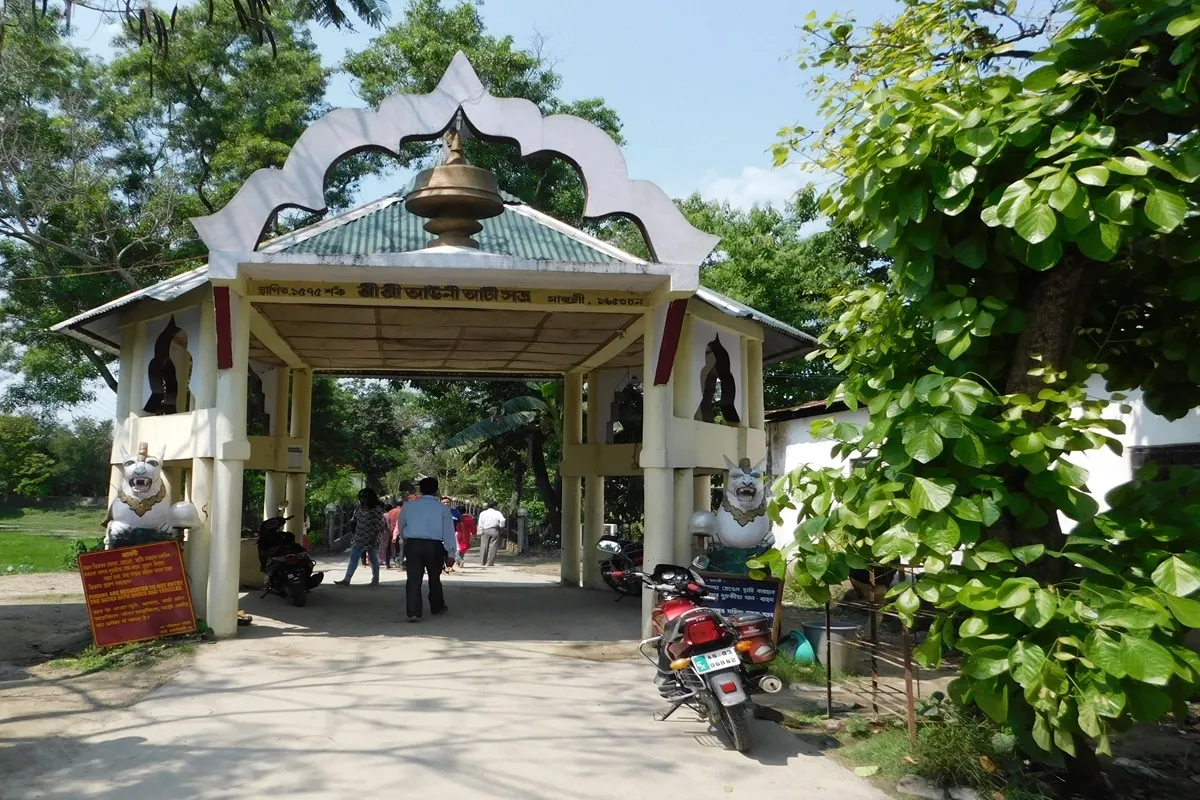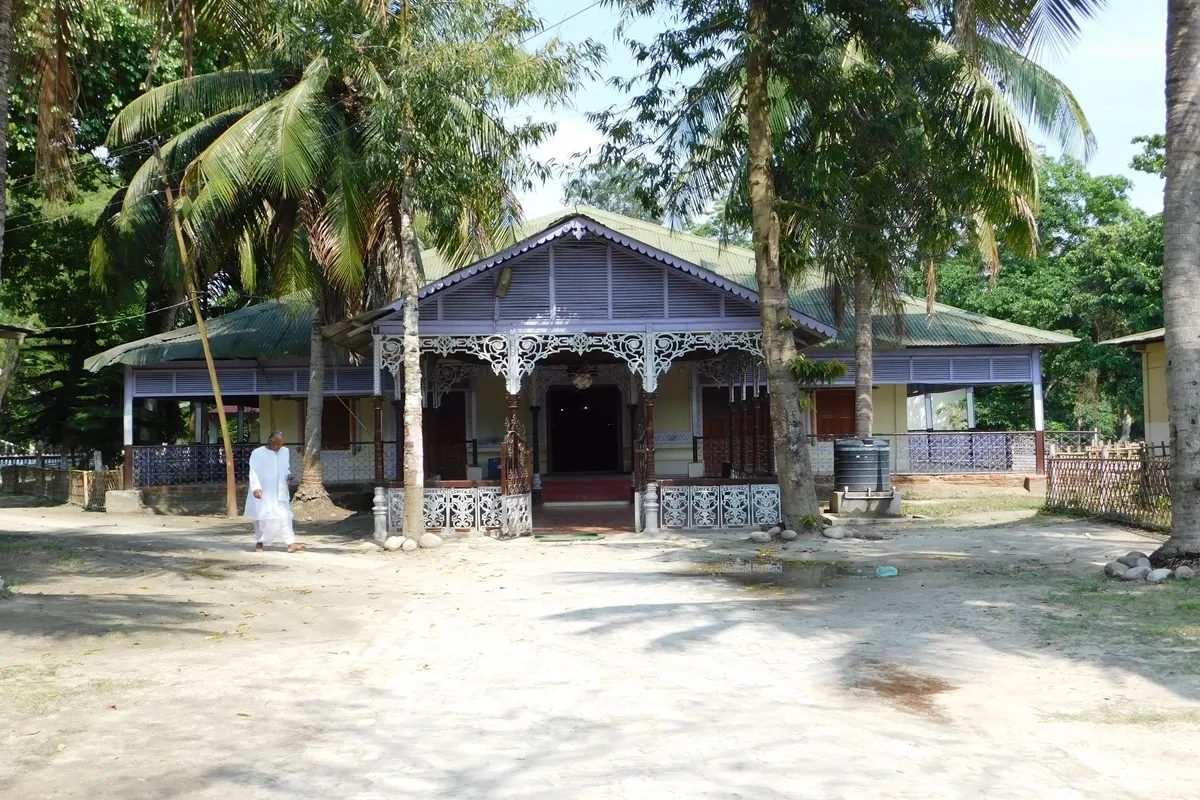Sri Sri Auniati Satra – An Overview
Established in Majuli in 1653 A.D. by Ahom King Sutamla, Sri Sri Auniati Satra holds a significant position among the various Satras of Assam. The name "Auniati" is derived from the slightly elevated land of Majuli, where the Satra was established, which was abundant in Auni Paan, a type of betel creeper plant. This Satra is a hub of Vaishnavism and Satriya culture in Assam and has been the epicenter of spiritual and cultural activities for more than 350 years.
Establishment and Historical Significance
Ahom King Sutamla, who later adopted the Hindu religion (Vaishnava) from the first Satradhikar of Auniati Satra, Sri Sri Niranjan Deva, established Sri Sri Auniati Satra in 1653. King Sutamla generously endowed 81,650 bighas of land in two categories, Devotra and Brohmotra, for the Satra's maintenance. This act of patronage by the Ahom Kings elevated the Satra's position among other Satras in Assam.
Religious Significance and Idol Worship
The main idol worshipped at Auniati Satra is Lord Krishna, known as Govinda. The idol was originally brought from Jagannath Kshetra (Puri, Orissa) and installed with Vedic religious rituals. Apart from the main idol, there are also other worship idols in the twelve branches of Auniati Satra located across Assam. The Satra's main branch is in North Guwahati, opposite Guwahati city, while another branch was established in Kaliapani in 2003.
Cultural Activities and Festivals
Sri Sri Auniati Satra is not only a place of worship but also a center for various cultural activities. The Satra is known for its Satriya performances, which include prayers, dances, and religious theatrical shows based on Indian epics such as the Puranas, Vedas, Ramayana, Mahabharata, and Srimad Bhagawat. Popular dance forms performed at Auniati Satra include Natua, Apsara, Sutradhar, Ozapali, Sali, Jumura, Krishna Gopi Nritya, and more.
The Satra also celebrates various festivals such as Paal-naam, Raas-leela, Janmastami, Holi, Dewali, Bohag Bihu, and Kati Bihu. These festivals are marked by special performances, devotional activities, and rituals. The Satradhikar, Deka Satradhikar, and Govindapuriya, along with their Vaishnava disciples, lead an ascetic life devoted to the worship of Lord Govinda.
Dwelling and Habitat at Auniati Satra
The Auniati Satra has a unique circular structure comprising a row of houses called Baha encircling the Namghar (temple) and Manikuta (idol temple) at the center. The Satradhikar, the main preceptor, resides near the temple premises, while the Deka Satradhikar and Govinda Puriya reside in designated areas within the Satra. The Bhakatas (Vaishnava devotees) live in huts arranged in four lines, known as Hati, on the east, west, north, and south sides of the Satra.
Significance of Auniati Satra in Majuli Island
Auniati Satra, situated in Majuli, the largest inhabited river island in the world, plays a pivotal role in preserving and promoting Vaishnavism and Satriya culture in Assam. With over 550 residents, the Satra serves as a center for the practice of Vaishnavism, religious discourses, and cultural activities. Devotees engage in daily prayers, Sharana, Bhajan, Nam-Prasanga, and religious festivals as a means of seeking spiritual fulfillment and promoting devotion to Lord Govinda.
Festivals and Ritual Activities
Auniati Satra celebrates various festivals and conducts special performances in the presence and under the supervision of the Satradhikar. Festivals like Paal-naam, Raas-leela, Janmastami, Holi, Dewali, Bohag Bihu, and Kati Bihu are ritually observed to commemorate significant events and please Lord Govinda. The Satra also commemorates the death anniversaries of past Satradhikaras and Vaishnavite Gurus.
The Satra's Satriya performances feature prayers, dances, and religious theatrical shows based on Puranas, Vedas, Ramayana, Mahabharata, and Srimad Bhagawat. These performances showcase art forms like Natua, Apsara, Sutradhar, Ozapali, Sali, Jumura, Krishna Gopi Nritya, and more. Satriya Geeta includes various forms of songs such as Gayana Geet, Janmastami Geet, Raas-Geet, Raja Gharia Geet, Guru Bandana, Deva Bandana, and Natarmajar Geet.
Auniati Satra's Role in Preserving Vaishnavite Culture
Auniati Satra is not only a religious institution but also a center for preserving and disseminating Vaishnavite culture. It engages in various literary pursuits, including biographical works of Vaishnavite Saints and cultural compositions like Bhaonas, Satriya songs and dances, and religious publications. The Satra also carries out preaching related to religious and societal works, promoting spiritual and cultural values among its followers.
The Satra has played a significant role in upholding and promoting the cultural heritage of Assam. It has branches in North Guwahati and Kaliapani, with millions of followers across the country. Auniati Satra is known for its cultural performances and has participated in national programs such as Republic Day celebrations, presentations at Rashtrapati Bhawan, and National Cultural festivals in various parts of India.
FAQs
What is the significance of Auniati Satra in Assam's cultural heritage?
The Auniati Satra holds immense significance in Assam's cultural heritage as it is one of the oldest Satras in the region, established in 1653. It serves as a center for preserving and promoting Vaishnavism and Satriya culture, which are integral parts of Assamese identity. The Satra's cultural activities, festivals, and literary pursuits contribute to the preservation and dissemination of Assam's rich cultural heritage.
What are the key features of Satriya culture preserved at Auniati Satra?
Satriya culture, also known as Sattriya, is an integral part of Auniati Satra's traditions. It encompasses various art forms such as dance, music, theater, and literature. The Satra is known for its Satriya dance performances, which include Natua, Apsara, Sutradhar, Ozapali, Sali, Jumura, Krishna Gopi Nritya, and more. Satriya songs, known as Satriya Geeta, are an essential element of the cultural performances at Auniati Satra.
What is the historical background of Auniati Satra and its connection to Vaishnavism?
Auniati Satra was established in 1653 A.D. by Ahom King Sutamla, who adopted the Hindu religion (Vaishnava) from the Satradhikar of Auniati Satra, Sri Sri Niranjan Deva. The Satra occupies a significant position among the various Satras of Assam and serves as a center for Vaishnavism, a bhakti movement that revolves around the worship of Lord Krishna. The main idol of Lord Krishna, Govinda, was brought from Jagannath Kshetra and installed at Auniati Satra.
How can visitors engage with the traditions and activities at Auniati Satra?
Visitors to Auniati Satra can witness the daily prayers and Satriya performances held in the general prayer hall (Naam-ghar). Special performances are conducted on occasions and festivals under the supervision of the Satradhikar. Visitors can also explore the Satra's premises, including the temple, museum, and library, to learn more about the cultural heritage and traditions preserved at Auniati Satra.
People Also Ask:
- What is the Satra culture of Assam?
- What is the Satriya culture of Majuli?
- What is Auniati Satra famous for?
- How many Satra are there in Assam?
- Who founded the Auniati Satra?
- What is the meaning of Auniati Satra?
- What is the history of satra?
High CPC Keywords:
- Assam spiritual tourism
- Vaishnavism in Assam
- Satriya culture in Assam
- Auniati Satra visit
- Assam heritage sites
- Assam cultural tours
- Auniati Satra history
- Satriya dance experience
- Assam religious sites
- Vaishnavite temples Assam





Post a Comment
0Comments